Flavonoid
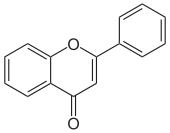


Flavonoids (or bioflavonoids; from the Latin word flavus, meaning yellow, their color in nature) are a class of polyphenolic secondary metabolites found in plants, and thus commonly consumed in the diets of humans.[1]
Chemically, flavonoids have the general structure of a 15-carbon skeleton, which consists of two
they can be classified into:- flavonoids or bioflavonoids
- isoflavonoids, derived from 3-phenylchromen-4-one (3-phenyl-1,4-benzopyrone) structure
- neoflavonoids, derived from 4-phenylcoumarin (4-phenyl-1,2-benzopyrone) structure
The three flavonoid classes above are all
History
In the 1930s, Albert Szent-Györgyi and other scientists discovered that Vitamin C alone was not as effective at preventing scurvy as the crude yellow extract from oranges, lemons or paprika. They attributed the increased activity of this extract to the other substances in this mixture, which they referred to as "citrin" (referring to citrus) or "Vitamin P" (a reference to its effect on reducing the permeability of capillaries). The substances in question (hesperidin, eriodictyol, hesperidin methyl chalcone and neohesperidin) were however later shown not to fulfil the criteria of a vitamin,[5] so that this term is now obsolete.[6]
Biosynthesis
Flavonoids are secondary metabolites synthesized mainly by plants. The general structure of flavonoids is a fifteen-carbon skeleton, containing two benzene rings connected by a three-carbon linking chain.

Functions of flavonoids in plants
Flavonoids are widely distributed in plants, fulfilling many functions.[1] They are the most important plant pigments for flower coloration, producing yellow or red/blue pigmentation in petals designed to attract pollinator animals. In higher plants, they are involved in UV filtration, symbiotic nitrogen fixation, and floral pigmentation. They may also act as chemical messengers, physiological regulators, and cell cycle inhibitors. Flavonoids secreted by the root of their host plant help Rhizobia in the infection stage of their symbiotic relationship with legumes like peas, beans, clover, and soy. Rhizobia living in soil are able to sense the flavonoids and this triggers the secretion of Nod factors, which in turn are recognized by the host plant and can lead to root hair deformation and several cellular responses such as ion fluxes and the formation of a root nodule. In addition, some flavonoids have inhibitory activity against organisms that cause plant diseases, e.g. Fusarium oxysporum.[7]
Subgroups
Over 5000 naturally occurring flavonoids have been characterized from various plants. They have been classified according to their chemical structure, and are usually subdivided into the following subgroups (for further reading see[8]):

Anthocyanidins

- Examples: cyanidin, delphinidin, malvidin, pelargonidin, peonidin, petunidin
Anthoxanthins
Anthoxanthins are divided into two groups:[9]
Group Skeleton Examples Description Functional groups Structural formula 3-hydroxyl 2,3-dihydro Flavone 2-phenylchromen-4-one ✗ ✗ 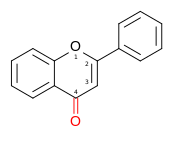 Tangeritin
TangeritinFlavonol
or
3-hydroxyflavone3-hydroxy-2-phenylchromen-4-one ✓ ✗  Furanoflavonols,
Furanoflavonols,
Flavanones
| Group | Skeleton | Examples | |||
|---|---|---|---|---|---|
| Description | Functional groups | Structural formula | |||
| 3-hydroxyl | 2,3-dihydro | ||||
Flavanone
|
2,3-dihydro-2-phenylchromen-4-one | ✗ | ✓ | 
|
Hesperetin, Naringenin, Eriodictyol, Homoeriodictyol |
Flavanonols
Flavans

Include
| Skeleton | Name |
|---|---|

|
Flavan-3-ol (flavanol) |

|
Flavan-4-ol |

|
Flavan-3,4-diol (leucoanthocyanidin)
|
- Flavan-3-ols(flavanols)
- Flavan-3-olsuse the 2-phenyl-3,4-dihydro-2H-chromen-3-ol skeleton
- Examples: Epigallocatechin 3-gallate(EGCg)
- Examples: Theaflavin-3,3'-digallate
- Thearubigin
- Proanthocyanidinsare dimers, trimers, oligomers, or polymers of the flavanols
Isoflavonoids
- Isoflavonoids
- Isoflavones use the 3-phenylchromen-4-one skeleton (with no hydroxyl group substitution on carbon at position 2)
- Isoflavanes
- Isoflavandiols
- Isoflavenes
- Coumestans
- Pterocarpans
Dietary sources
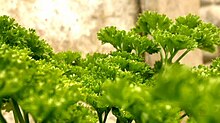
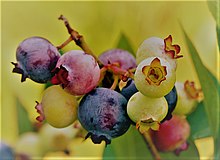

Flavonoids (specifically flavanoids such as the
Foods with a high flavonoid content include
Citrus flavonoids include
Peanut (red) skin contains significant polyphenol content, including flavonoids.[15][16]
Flavonoid content in food (mg/100 g)[1] Food source Flavones Flavonols Flavanones Red onion 0 4–100 0 Parsley, fresh 24–634 8–10 0 Thyme, fresh 56 0 0 Lemon juice, fresh 0 0–2 2–175
Dietary intake
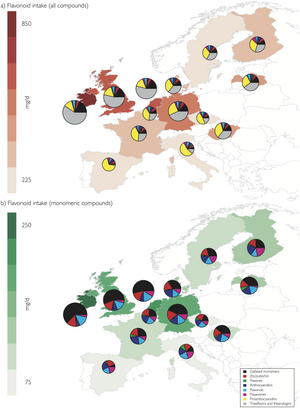

Research
Neither the United States Food and Drug Administration (FDA) nor the European Food Safety Authority (EFSA) has approved any flavonoids as prescription drugs.[1][19][20][21] The U.S. FDA has warned numerous dietary supplement and food manufacturers, including Unilever, producer of Lipton tea in the U.S., about illegal advertising and misleading health claims regarding flavonoids, such as that they lower cholesterol or relieve pain.[22][23]
Metabolism and excretion
Flavonoids are poorly absorbed in the human body (less than 5%), then are quickly metabolized into smaller fragments with unknown properties, and rapidly excreted.[1][21][24][25] Flavonoids have negligible antioxidant activity in the body, and the increase in antioxidant capacity of blood seen after consumption of flavonoid-rich foods is not caused directly by flavonoids, but by production of uric acid resulting from flavonoid depolymerization and excretion.[1] Microbial metabolism is a major contributor to the overall metabolism of dietary flavonoids.[1][26] The effect of habitual flavonoid intake on the human gut microbiome is unknown.[1][27]
Inflammation
Cancer
Clinical studies investigating the relationship between flavonoid consumption and cancer prevention or development are conflicting for most types of cancer, probably because most human studies have weak designs, such as a small sample size.[1][32] There is little evidence to indicate that dietary flavonoids affect human cancer risk in general.[1]
Cardiovascular diseases
Although no significant association has been found between flavan-3-ol intake and cardiovascular disease mortality, clinical trials have shown improved endothelial function and reduced blood pressure (with a few studies showing inconsistent results).[1] Reviews of cohort studies in 2013 found that the studies had too many limitations to determine a possible relationship between increased flavonoid intake and decreased risk of cardiovascular disease, although a trend for an inverse relationship existed.[1][33]
In 2013, the EFSA decided to permit health claims that 200 mg/day of cocoa flavanols "help[s] maintain the elasticity of blood vessels."[34][35] The FDA followed suit in 2023, stating that there is "supportive, but not conclusive" evidence that 200 mg per day of cocoa flavanols can reduce the risk of cardiovascular disease. This is greater than the levels found in typical chocolate bars, which can also contribute to weight gain, potentially harming cardiovascular health.[36][37]
Synthesis, detection, quantification, and semi-synthetic alterations
Color spectrum
Flavonoid synthesis in plants is induced by light color spectrums at both high and low energy radiations. Low energy radiations are accepted by phytochrome, while high energy radiations are accepted by carotenoids, flavins, cryptochromes in addition to phytochromes. The photomorphogenic process of phytochrome-mediated flavonoid biosynthesis has been observed in Amaranthus, barley, maize, Sorghum and turnip. Red light promotes flavonoid synthesis.[38]
Availability through microorganisms
Research has shown production of flavonoid molecules from genetically engineered microorganisms.[39][40]
Tests for detection
Shinoda test
Four pieces of magnesium filings are added to the ethanolic extract followed by few drops of concentrated
Sodium hydroxide test
About 5 mg of the compound is dissolved in water, warmed, and filtered. 10% aqueous sodium hydroxide is added to 2 ml of this solution. This produces a yellow coloration. A change in color from yellow to colorless on addition of dilute hydrochloric acid is an indication for the presence of flavonoids.[42]
p-Dimethylaminocinnamaldehyde test
A colorimetric assay based upon the reaction of A-rings with the chromogen
Quantification
Lamaison and Carnet have designed a test for the determination of the total flavonoid content of a sample (AlCI3 method). After proper mixing of the sample and the reagent, the mixture is incubated for ten minutes at ambient temperature and the absorbance of the solution is read at 440 nm. Flavonoid content is expressed in mg/g of quercetin.[44]
Semi-synthetic alterations
Immobilized
See also
- Phytochemical
- List of antioxidants in food
- List of phytochemicals in food
- Phytochemistry
- Secondary metabolites
- Homoisoflavonoids, related chemicals with a 16 carbons skeleton
References
- ^ a b c d e f g h i j k l m n o p q r s t u v Delage B (November 2015). "Flavonoids". Linus Pauling Institute, Oregon State University, Corvallis, Oregon. Retrieved January 26, 2021.
- ^ PMID 33842761.
- ISBN 978-0-9678550-9-7
- ISBN 978-0-9678550-9-7. Retrieved September 16, 2012.
- ISBN 978-0-08-086604-8.
- ISBN 978-1-351-08601-1.
- .
- S2CID 24986941.
- .
- PMID 18503736.
- ^ a b c d e f USDA’s Database on the Flavonoid Content
- .
- S2CID 41271401.
- ^ Levaj B, et al. (2009). "Determination of flavonoids in pulp and peel of mandarin fruits (table 1)" (PDF). Agriculturae Conspectus Scientificus. 74 (3): 223. Archived from the original (PDF) on 2017-08-10. Retrieved 2020-07-31.
- .
- PMID 20087468.
- ^ PMID 26010916.
- ^ PMID 17449588.
- ^ "FDA approved drug products". US Food and Drug Administration. Retrieved November 8, 2013.
- ^ "Health Claims Meeting Significant Scientific Agreement". US Food and Drug Administration. Retrieved November 8, 2013.
- ^ .
- NPR. Retrieved June 17, 2023.
- ^ "Cherry companies warned by FDA against making health claims". The Produce News. November 1, 2005. Retrieved June 17, 2023.
- PMID 17157175.
- PMID 15019969.
- PMID 22439618.
- PMID 31551328.
- PMID 24128857.
- S2CID 794383.
- PMID 24029069.
- PMID 22606367.
- S2CID 205960210.
- PMID 23953879.
- . Retrieved June 17, 2023.
- ^ "Cocoa flavanol health claim becomes EU law". Confectionary News. September 4, 2013. Retrieved June 17, 2023.
- ^ Kavanaugh C (February 1, 2023). RE: Petition for a Qualified Health Claim – for Cocoa Flavanols and Reduced Risk of Cardiovascular Disease (Docket No. FDA-2019-Q-0806) (Report). FDA.
- NPR. Retrieved June 17, 2023.
- ISBN 9780849317149.
- PMID 19631278.
- S2CID 5805643.
- ^ Yisa J (2009). "Phytochemical Analysis and Antimicrobial Activity of Scoparia dulcis and Nymphaea lotus". Australian Journal of Basic and Applied Sciences. 3 (4): 3975–3979. Archived from the original on October 17, 2013.
- PMID 22373191.
- .
- ^ Lamaison JL, Carnet A (1991). "Teneurs en principaux flavonoïdes des fleurs de Cratageus monogyna Jacq. et de Cratageus laevigata (Poiret D.C.) en fonction de la végétation" [Principal flavonoid content of flowers of Cratageus monogyna Jacq. and Cratageus laevigata (Poiret D.C.) dependent on vegetation]. Plantes Medicinales: Phytotherapie (in French). 25: 12–16.
- S2CID 26716150.
Further reading
- Andersen ØM, Markham KR (2006). Flavonoids: Chemistry, Biochemistry and Applications. Boca Raton, FL: CRC Press, Taylor & Francis. ISBN 978-0-8493-2021-7.
- Grotewold E (2006). The science of flavonoids. New York: Springer. ISBN 978-0-387-74550-3.
- Harborne JB (1967). Comparative Biochemistry of the Flavonoids.
- Mabry TJ, Markham KR, Thomas MB (1971). "The systematic identification of flavonoids". Journal of Molecular Structure. 10 (2): 320. .



